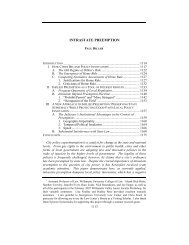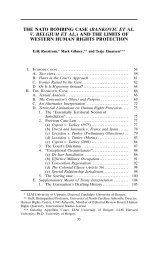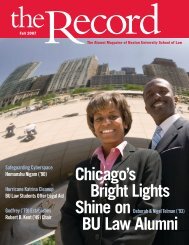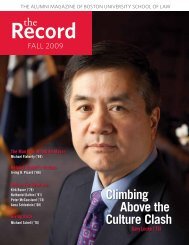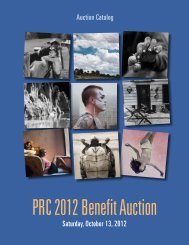the nature of representation: the cherokee right ... - Boston University
the nature of representation: the cherokee right ... - Boston University
the nature of representation: the cherokee right ... - Boston University
Create successful ePaper yourself
Turn your PDF publications into a flip-book with our unique Google optimized e-Paper software.
2005] THE NATURE OF REPRESENTATION 139<br />
emigrated under John Ross’s leadership, while <strong>the</strong> Eastern Band in North Carolina<br />
avoided removal. The Keetoowah Band left Georgia earlier than <strong>the</strong> main group <strong>of</strong><br />
Cherokees, expecting <strong>the</strong> o<strong>the</strong>r Cherokees to be forced to follow <strong>the</strong>m. This Band<br />
is also known as <strong>the</strong> “Old Settlers” or “Western Cherokees.”<br />
Sorting through three separate Cherokee tribes appears to be challenging.<br />
Arguably, <strong>the</strong> Cherokees deserving <strong>of</strong> a delegate <strong>right</strong> are <strong>the</strong> members <strong>of</strong> <strong>the</strong><br />
Cherokee Nation <strong>of</strong> Oklahoma since <strong>the</strong>y were <strong>the</strong> only Cherokees whose ancestors<br />
emigrated under <strong>the</strong> 1835 treaty. If <strong>the</strong> delegate <strong>right</strong> is understood as part <strong>of</strong> a<br />
bargained-for exchange, <strong>the</strong> Eastern Band Cherokees were not removed and <strong>the</strong> Old<br />
Settlers left without inducement from <strong>the</strong> treaty. Arguably, <strong>the</strong>se tribes have less <strong>of</strong><br />
a claim to <strong>the</strong> delegate <strong>right</strong> because <strong>the</strong>y were not parties to <strong>the</strong> Treaty <strong>of</strong> New<br />
Echota. Limiting <strong>the</strong> delegate <strong>right</strong> to <strong>the</strong> Cherokee Nation <strong>of</strong> Oklahoma makes<br />
sense legally, but also conflicts with <strong>the</strong> ideal <strong>of</strong> treating <strong>the</strong> Cherokee as a single<br />
people.<br />
For a tribe whose leader at <strong>the</strong> time <strong>of</strong> removal was only 1/8 th Cherokee, it is not<br />
surprising that issues <strong>of</strong> race and blood quantum might complicate <strong>the</strong> definition <strong>of</strong><br />
who would be represented by <strong>the</strong> Cherokee delegate. An additional complication<br />
arises from <strong>the</strong> fact that “[a]mong Native-American tribes, <strong>the</strong> Cherokee nation is<br />
not unusual in requiring some Cherokee blood for membership, but it is remarkable<br />
for having no minimum biogenic standard, no minimum degree <strong>of</strong> blood, for<br />
citizenship.” 249 During <strong>the</strong> removal era, U.S. <strong>of</strong>ficials accused Cherokee leaders <strong>of</strong><br />
being white men in order to discredit <strong>the</strong>m and deny <strong>the</strong> significance <strong>of</strong> <strong>the</strong>ir<br />
protests against removal. 250<br />
In Blood Politics: Race, Culture, and Identity in <strong>the</strong><br />
Cherokee Nation <strong>of</strong> Oklahoma, Circe Sturm writes about “a growing fear among<br />
Cherokees that <strong>the</strong>y might lose <strong>the</strong>ir political status as a result <strong>of</strong> <strong>the</strong>ir increasingly<br />
phenotypically white population.” 251 Discussing <strong>the</strong> challenges that race presents<br />
for exercising Cherokee political <strong>right</strong>s Sturm continues, “as <strong>the</strong> Cherokee Nation<br />
progressively ‘whitens,’ it runs <strong>the</strong> risk <strong>of</strong> losing its distinct racial and cultural<br />
identity, <strong>the</strong> primordial substance <strong>of</strong> its national identity. In <strong>the</strong> eyes <strong>of</strong> <strong>the</strong> general<br />
public, <strong>the</strong> Cherokee Nation would no longer be a ‘real’ Indian tribe.” 252<br />
As <strong>the</strong> history <strong>of</strong> removal and Sturm’s writing indicates, <strong>the</strong> Cherokee racial<br />
challenge is largely tied to <strong>the</strong> difficulties non-Cherokees 253 have accepting ‘whitelooking’<br />
or low percentage Indian blood Cherokees as Indians with <strong>right</strong>s not<br />
shared by non-Indians. A Cherokee delegate would dramatize and nationalize <strong>the</strong><br />
States Bureau <strong>of</strong> Indian Affairs; Notice, 68 Fed. Reg. 234 (Dec. 5, 2003).<br />
249 STURM, supra note 20, at 89.<br />
250 See supra, Section III (3)(b).<br />
251 STURM, supra note 20, at 99.<br />
252<br />
Id. at 99-100.<br />
253 “Non-Cherokees” is chosen over more narrowly focusing on whites, because<br />
o<strong>the</strong>r Indians who are members <strong>of</strong> tribes whose rules require a larger blood quantum for<br />
membership (<strong>the</strong> Navajos require 1/4 th Indian blood for membership, for example) <strong>of</strong>ten<br />
share some <strong>of</strong> <strong>the</strong> same views as whites do on light-skinned or low blood quantum<br />
Cherokees.



